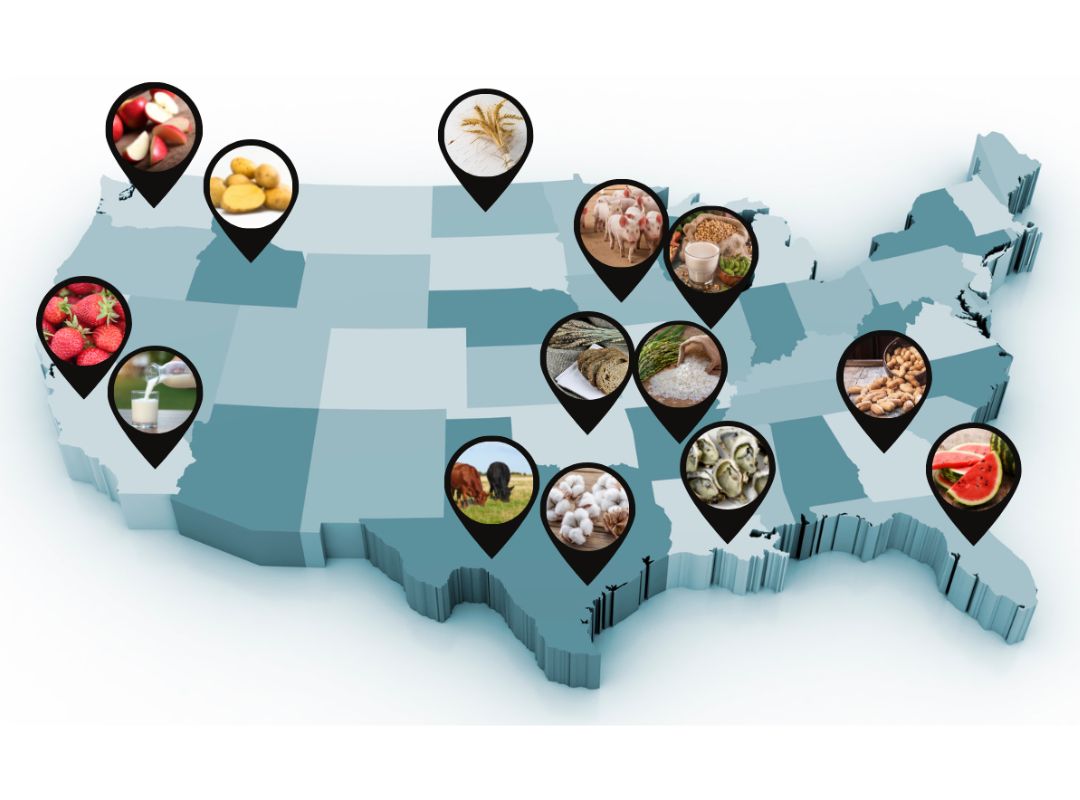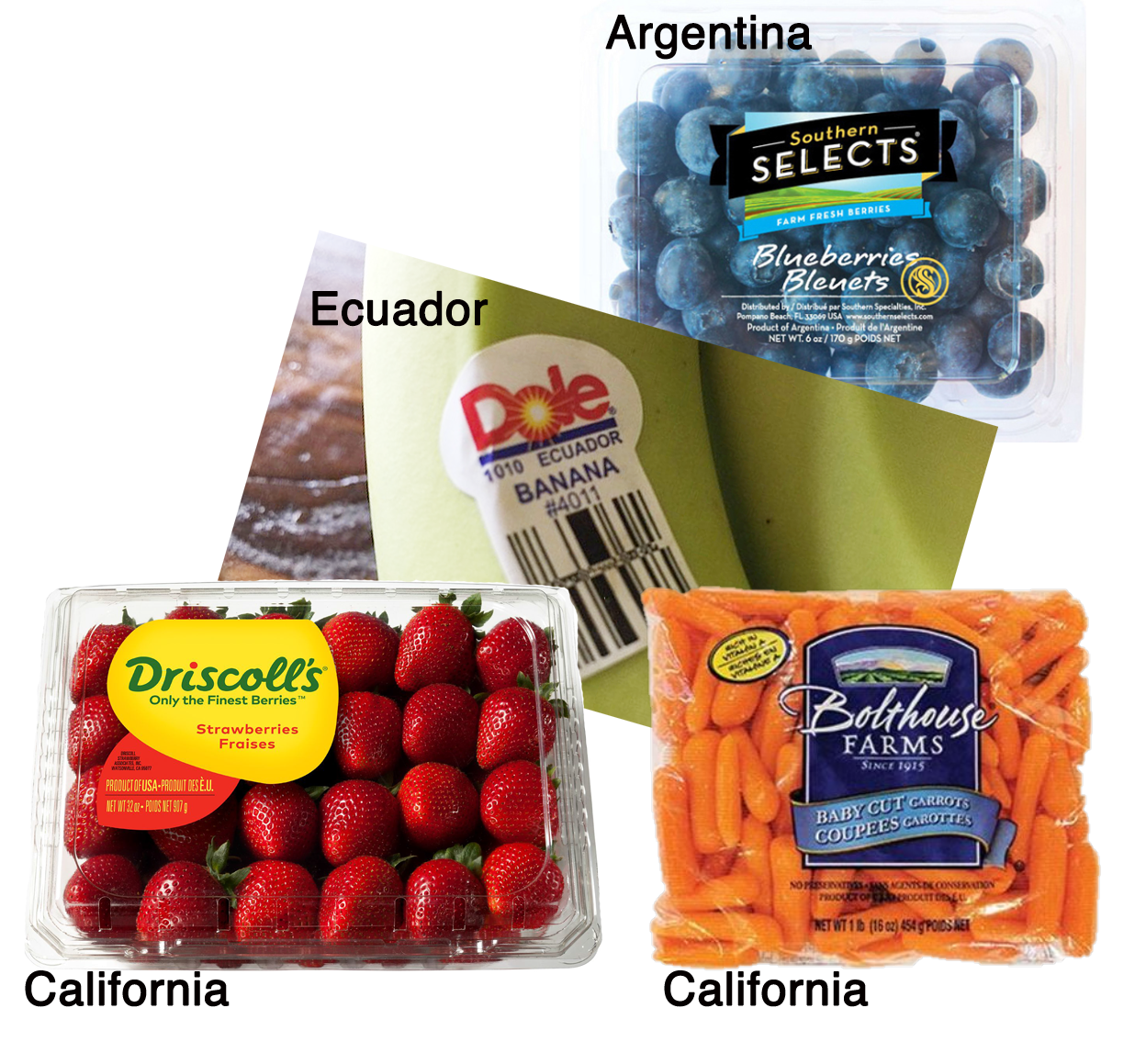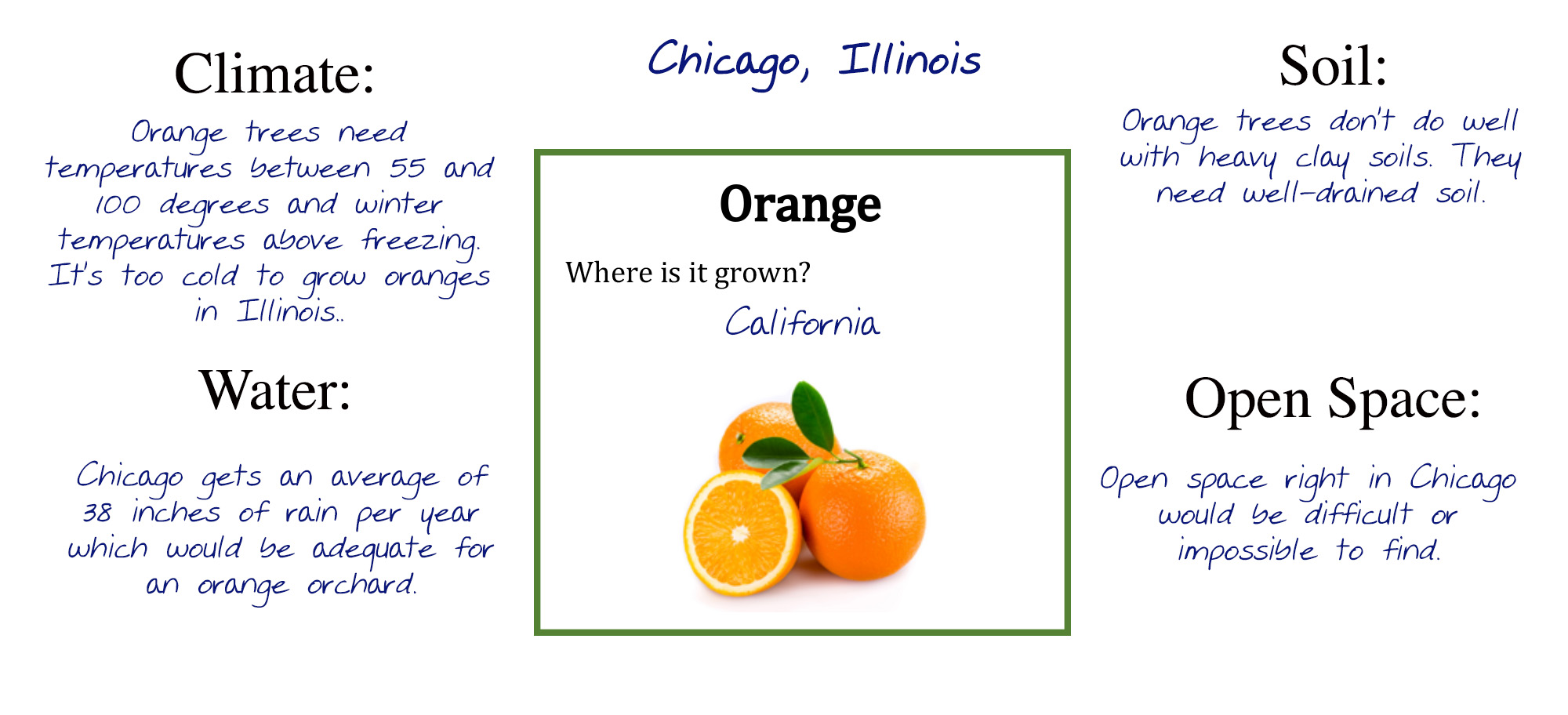Geography and Climate for Agricultural Landscapes (Grades 9-12)
Students will discover how geography and climate influence the crops that are grown and the livestock that is raised in each state.

Background
Lesson Activities
Recommended Companion Resources
Credits
Author
Andrea Gardner and Debra Spielmaker | National Center for Agricultural Literacy (NCAL)
Standards
Texas Content Area Standards
-
Principles of Agriculture, Food, and Natural Resources: 130.2.c.1
The student demonstrates professional standards/employability skills as required by business and industry. The student is expected to:
- Principles of Agriculture, Food, and Natural Resources: 130.2.c.1.B: apply competencies related to resources, information, interpersonal skills, problem solving, critical thinking, and systems of operation in agriculture, food, and natural resources.
-
Principles of Agriculture, Food, and Natural Resources: 130.2.c.4
The student explains the historical, current, and future significance of the agriculture, food, and natural resources industry. The student is expected to:
- Principles of Agriculture, Food, and Natural Resources: 130.2.c.4.B: analyze the scope of agriculture, food, and natural resources and its effect upon society.
- Principles of Agriculture, Food, and Natural Resources: 130.2.c.4.F: compare and contrast issues impacting agriculture, food, and natural resources such as biotechnology, employment, safety, environment, and animal welfare issues.
-
Principles of Agriculture, Food, and Natural Resources: 130.2.c.6
The student demonstrates appropriate personal and communication skills. The student is expected to:
- Principles of Agriculture, Food, and Natural Resources: 130.2.c.6.A: demonstrate written and oral communication skills appropriate for formal and informal situations such as prepared and extemporaneous presentations.
- Principles of Agriculture, Food, and Natural Resources: 130.2.c.6.B: demonstrate effective listening skills appropriate for formal and informal situations.
-
Principles of Agriculture, Food, and Natural Resources: 130.2.c.10
The student develops technical knowledge and skills related to soil systems. The student is expected to:
- Principles of Agriculture, Food, and Natural Resources: 130.2.c.10.A: identify the components and properties of soils.
-
World History Studies: 113.42.c.29
Social studies skills. The student uses geographic skills and tools to collect, analyze, and interpret data.
- World History Studies: 29.A: The student is expected to create and interpret thematic maps, graphs, and charts to demonstrate the relationship between geography and the historical development of a region or nation.
- World History Studies: 29.B: The student is expected to analyze and compare geographic distributions and patterns in world history shown on maps, graphs, charts, and models.
-
World Geography Studies: 113.43.c.9
Geography. The student understands the concept of region as an area of Earth's surface with related geographic characteristics.
- World Geography Studies: 9.A: The student is expected to identify physical and/or human factors such as climate, vegetation, language, trade networks, political units, river systems, and religion that constitute a region.
-
English I: 110.36.c.1
Developing and sustaining foundational language skills: listening, speaking, discussion, and thinking--oral language. The student develops oral language through listening, speaking, and discussion.
- English I: 1.A: The student is expected to engage in meaningful and respectful discourse by listening actively, responding appropriately, and adjusting communication to audiences and purposes.
- English I: 1.B: The student is expected to follow and give complex oral instructions to perform specific tasks, answer questions, or solve problems and complex processes.
- English I: 1.C: The student is expected to give a presentation using informal, formal, and technical language effectively to meet the needs of audience, purpose, and occasion, employing eye contact, speaking rate such as pauses for effect, volume, enunciation, purposeful gestures, and conventions of language to communicate ideas effectively.
- English I: 1.D: The student is expected to participate collaboratively, building on the ideas of others, contributing relevant information, developing a plan for consensus building, and setting ground rules for decision making.
-
English I: 110.36.c.11
Inquiry and research: listening, speaking, reading, writing, and thinking using multiple texts. The student engages in both short-term and sustained recursive inquiry processes for a variety of purposes.
- English I: 11.E: The student is expected to locate relevant sources.
- English I: 11.F: The student is expected to synthesize information from a variety of sources.
- English I: 11.I: The student is expected to use an appropriate mode of delivery, whether written, oral, or multimodal, to present results.
-
English I: 110.36.c.4
Comprehension skills: listening, speaking, reading, writing, and thinking using multiple texts. The student uses metacognitive skills to both develop and deepen comprehension of increasingly complex texts.
- English I: 4.D: The student is expected to create mental images to deepen understanding.
- English I: 4.G: The student is expected to evaluate details read to determine key ideas.
-
English I: 110.36.c.5
Response skills: listening, speaking, reading, writing, and thinking using multiple texts. The student responds to an increasingly challenging variety of sources that are read, heard, or viewed.
- English I: 5.B: The student is expected to write responses that demonstrate understanding of texts, including comparing texts within and across genres.
- English I: 5.D: The student is expected to paraphrase and summarize texts in ways that maintain meaning and logical order.
- English I: 5.E: The student is expected to interact with sources in meaningful ways such as notetaking, annotating, freewriting, or illustrating.
-
English II: 110.37.c.4
Comprehension skills: listening, speaking, reading, writing, and thinking using multiple texts. The student uses metacognitive skills to both develop and deepen comprehension of increasingly complex texts.
- English II: 4.E: The student is expected to make connections to personal experiences, ideas in other texts, and society.
- English II: 4.G: The student is expected to evaluate details read to determine key ideas.
-
English II: 110.37.c.1
Developing and sustaining foundation language skills: listening, speaking, discussion, and thinking--oral language. The student develops oral language through listening, speaking, and discussion.
- English II: 1.A: The student is expected to engage in meaningful and respectful discourse by listening actively, responding appropriately, and adjusting communication to audiences and purposes.
- English II: 1.B: The student is expected to follow and give complex oral instructions to perform specific tasks, answer questions, or solve problems and complex processes.
- English II: 1.C: The student is expected to give a formal presentation that incorporates a clear thesis and a logical progression of valid evidence from reliable sources and that employs eye contact, speaking rate such as pauses for effect, volume, enunciation, purposeful gestures, and conventions of language to communicate ideas effectively.
- English II: 1.D: The student is expected to participate collaboratively, building on the ideas of others, contributing relevant information, developing a plan for consensus building, and setting ground rules for decision making.
-
English III: 110.38.c.1
Developing and sustaining foundational language skills: listening, speaking, discussion, and thinking--oral language. The student develops oral language through listening, speaking, and discussion.
- English III: 1.A: The student is expected to engage in meaningful and respectful discourse when evaluating the clarity and coherence of a speaker's message and critiquing the impact of a speaker's use of diction and syntax.
- English III: 1.B: The student is expected to follow and give complex instructions, clarify meaning by asking pertinent questions, and respond appropriately.
- English III: 1.C: The student is expected to give a formal presentation that exhibits a logical structure, smooth transitions, accurate evidence, well-chosen details, and rhetorical devices and that employs eye contact, speaking rate such as pauses for effect, volume, enunciation, purposeful gestures, and conventions of language to communicate ideas effectively.
- English III: 1.D: The student is expected to participate collaboratively, offering ideas or judgements that are purposeful in moving the team toward goals, asking relevant and insightful questions, tolerating a range of positions and ambiguity in decision making, and evaluating the work of the group based on agreed-upon criteria.
-
English III: 110.38.c.4
Comprehension skills: listening, speaking, reading, writing, and thinking using multiple texts. The student uses metacognitive skills to both develop and deepen comprehension of increasingly complex texts.
- English III: 4.E: The student is expected to make connections to personal experiences, ideas in other texts, and society.
- English III: 4.G: The student is expected to evaluate details read to understand key ideas.
-
English II: 110.37.c.11
Inquiry and research: listening, speaking, reading, writing, and thinking using multiple texts. The student engages in both short-term and sustained recursive inquiry processes for a variety of purposes.
- English II: 11.E: The student is expected to locate relevant sources.
- English II: 11.F: The student is expected to synthesize information from a variety of sources.
- English II: 11.I: The student is expected to use an appropriate mode of delivery, whether written, oral, or multimodal, to present results.
-
English III: 110.38.c.5
Response skills: listening, speaking, reading, writing, and thinking using multiple texts. The student responds to an increasingly challenging variety of sources that are read, heard, or viewed.
- English III: 5.B: The student is expected to write responses that demonstrate analysis of texts, including comparing texts within and across genres.
- English III: 5.D: The student is expected to paraphrase and summarize texts in ways that maintain meaning and logical order.
- English III: 5.E: The student is expected to interact with sources in meaningful ways such as notetaking, annotating, freewriting, or illustrating.
-
English II: 110.37.c.5
Response skills: listening, speaking, reading, writing, and thinking using multiple texts. The student responds to an increasingly challenging variety of sources that are read, heard, or viewed.
- English II: 5.B: The student is expected to write responses that demonstrate understanding of texts, including comparing texts within and across genres.
- English II: 5.D: The student is expected to paraphrase and summarize texts in ways that maintain meaning and logical order.
- English II: 5.E: The student is expected to interact with sources in meaningful ways such as notetaking, annotating, freewriting, or illustrating.
-
English III: 110.38.c.11
Inquiry and research: listening, speaking, reading, writing, and thinking using multiple texts. The student engages in both short-term and sustained recursive inquiry processes for a variety of purposes.
- English III: 11.E: The student is expected to locate relevant sources.
- English III: 11.F: The student is expected to synthesize information from a variety of sources.
- English III: 11.I: The student is expected to use an appropriate mode of delivery, whether written, oral, or multimodal, to present results.
-
English IV: 110.39.c.1
Developing and sustaining foundational language skills: listening, speaking, discussion, and thinking--oral language. The student develops oral language through listening, speaking, and discussion.
- English IV: 1.A: The student is expected to engage in meaningful and respectful discourse when evaluating the clarity and coherence of a speaker's message and critiquing the impact of a speaker's use of diction, syntax, and rhetorical strategies.
- English IV: 1.B: The student is expected to follow and give complex instructions, clarify meaning by asking pertinent questions, and respond appropriately.
- English IV: 1.C: The student is expected to formulate sound arguments and present using elements of classical speeches such as introduction, first and second transitions, body, conclusion, the art of persuasion, rhetorical devices, employing eye contact, speaking rate such as pauses for effect, volume, enunciation, purposeful gestures, and conventions of language to communicate ideas effectively.
- English IV: 1.D: The student is expected to participate collaboratively, offering ideas or judgements that are purposeful in moving the team toward goals, asking relevant and insightful questions, tolerating a range of positions and ambiguity in decision making, and evaluating the work of the group based on agreed-upon criteria.
-
English IV: 110.39.c.4
Comprehension skills: listening, speaking, reading, writing, and thinking using multiple texts. The student uses metacognitive skills to both develop and deepen comprehension of increasingly complex texts.
- English IV: 4.E: The student is expected to make connections to personal experiences, ideas in other texts, and society.
- English IV: 4.G: The student is expected to evaluate details read to analyze key ideas.
-
English IV: 110.39.c.5
Response skills: listening, speaking, reading, writing, and thinking using multiple texts. The student responds to an increasingly challenging variety of sources that are read, heard, or viewed.
- English IV: 5.B: The student is expected to write responses that demonstrate analysis of texts, including comparing texts within and across genres.
- English IV: 5.D: The student is expected to paraphrase and summarize texts in ways that maintain meaning and logical order.
- English IV: 5.E: The student is expected to interact with sources in meaningful ways such as notetaking, annotating, freewriting, or illustrating.
-
English IV: 110.39.c.11
Inquiry and research: listening, speaking, reading, writing, and thinking using multiple texts. The student engages in both short-term and sustained recursive inquiry processes for a variety of purposes.
- English IV: 11.E: The student is expected to locate relevant sources.
- English IV: 11.F: The student is expected to synthesize information from a variety of sources.
- English IV: 11.I: The student is expected to use an appropriate mode of delivery, whether written, oral, or multimodal, to present results.
-
Advanced Plant and Soil Science: 130.25.c.9
The student analyzes soil science as it relates to food and fiber production. The student is expected to:
- Advanced Plant and Soil Science: 130.25.c.9.B: evaluate the properties and nature of soils.
-
Advanced Plant and Soil Science: 130.25.c.10
The student describes the relationship between resources within environmental systems. The student is expected to:
- Advanced Plant and Soil Science: 130.25.c.10.D: analyze and evaluate the economic significance and interdependence of components of the environment.

